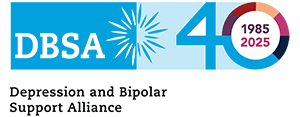- Coloring Pages
- Trauma and Mood Disorders
- Find Hope Toolkit
- Find hope social media toolkit
- Gerald L. Klerman Young Investigator Award Nomination Form
- Gerald L. Klerman Senior Investigator Award Nomination Form
- Parent and Caregiver Story - Kimberly King
- Maternal Mental Health
- Honoring Women and Spreading Awareness
- Gerald L. Klerman 2024 RSVP
- DBSA Peer Apprentices Finding Community, Wellness, and Hope with DBSA's Peer Apprentice Program
- Donate to DBSA
- Living at the Intersection of Multiple Diagnoses
- Fundraising Assets
- Join Our Community
- Join Our Movement
- SAB Membership Update
- 2023 Year End
- Raising Our Hands
- Brightening Lives Social Media Kit
- Giving Thanks
- Action Alert: Safe Step Act
- Tribute to Hannah Zeller, MSW
- Virtual Peer Specialist Q&A
- Bridging the mental health gap for Black Americans
- Living Successfully Post Course Survey
- DBSA Online Support Groups
- Thank you for your donation
- Associate Board Application
- Fall 2024 Report
- Why Attend a DBSA Support Group?
- Interview with Jean Dukarski
- #GivingTuesday with DBSA
- Thank You!
- #GivingTuesday 2024
- IAB Individual Giving Survey
- Share Wellness with Peers
- #GivingTuesday Gift Confirmation
- Together, we are a Voice of Hope.
- About DBSA Peer Specialist Training Course
- World Bipolar Day; Ask DBSA.
- Support Trusted Mental Health Resources – Give to DBSA Today
- Support the Dauten Scholarship Fund
- Dauten Scholarship Fund
- World Bipolar Day - Ask the Expert
- Q: Bipolar disorder was previously known as:
- Bipolar Disorder Quiz
- 2025 Communications Survey Drawing
- DBSA 2025 Scientific Advisory Board Reception & Gerald L. Klerman Award Presentation
- Support Mental Health with DBSA
- Step by Step, You Change Lives
- Mental Health Awareness
- Men’s Mental Health
- Donate Now to Protect Access to Mental Health Support
- Peer Leadership and Education Convening
- 2022 MHLG Organization Contacts
- Leadership Summit Video Submission
- I’m Living Proof: A Letter to My Younger Self
- DBSA Outreach to the Black Community
- Heartbreaking Loss Amidst the Pandemic: Our Mental Health Crisis
- 2021 MHLG Organization Contacts
- Young Adult Council spotlight: Surviving a suicide attempt
- The making of Psychiatrist as Patient: Caring for the Caregiver
- Psychiatrist as Patient: Caring for the Caregiver
- John Budin | Psychiatrist as Patient
- DBSA Resources to Support Youth Mental Health
- Hope, Progress, Leadership: A Look at DBSA's History
- Mood Crew
- Racism: a threat to our nation’s mental health
- What to expect when you attend an online support group
- At-Home Resources for Young Adults
- COVID-19 Resources
- Position / Policy Overview and Recommendation: Personal and Civil Rights: Right to Live in the Community
- Position / Policy Overview and Recommendation: Personal and Civil Rights: Safe Gun Ownership
- Position/Policy Overview and Recommendation: Personal and Civil Rights: Privacy of Personal Health Information
- Position/Policy Overview and Recommendation: Peer Support Services
- Position/Policy Overview and Recommendation: Youth Mental Health
- 2020 DBSA Virtual Leadership Summit
- Supporting Youth Mental Health Story Submission
- Appalachian Mind Health Initiative
- First Responders
- 2020 MHLG Organization Contacts
- Activity
- Members
- Montaja Simmons
- Erica Kadel
- Allison Francis Barksdale
- International Support Groups
- DBSAlianza.org
- Managing Your Depression
- 2019 MHLG Organization Contacts
- DBSA Legacy of Wellness Enrollment
- Terms of Use and Privacy Statement
- Organizational Management
- Helping a Friend or Family Member
- Privacy Policy
- Member Login
- DBSA Survey Center
- Cart
- Checkout
- Lifestyle
- Setting & Achieving Goals
- Career Opportunities
- About DBSA
- Finding Your Treatment Team
- Advocate for Mental Health
- Brochures
- Crisis
- Technological Treatments
- Toolkits
- Education
- Get Involved
- Home
- I’m here… Campaign Podcasts
- Mental Health Podcasts
- Meet Our Team
- Podcasts
- Programs
- Sections Example
- Stories
- Support
- Wellness
Treatment for depression and bipolar disorder often include four elements: talk therapy, medication, peer support, and a personal wellness plan. Sometimes, though, these aren’t enough. Fortunately, there are several other biological treatments currently in use that have been shown to help reduce symptoms of depression or bipolar disorder.
Electroconvulsive Therapy (ECT)
In the 1930s, ECT was discovered when researchers learned that applying a small amount of electrical current to the brain caused small mild seizures that changed brain chemistry. Over the years, much has been done to make this form of treatment milder and easier for people to tolerate. During ECT, a machine is used to send small electrical currents to the brain. These currents cause a seizure that lasts about 30 seconds. Treatment is usually repeated two or three times a week over a period of a few weeks. ECT can be effective in treating severe depression. However, there can be side effects such as confusion and memory loss. The procedure must be performed in a hospital with general anesthesia.
Transcranial Magnetic Stimulation (TMS)
TMS works by using a special electromagnetic device that is placed on the scalp and sends short bursts of energy to the brain. These pulses of energy stimulate nerve cells in the part of the brain that’s associated with mood regulation. TMS therapy does not require surgery, hospitalization, or anesthesia. The side effects associated with TMS, such as a mild headache or lightheadedness, are relatively infrequent and usually go away soon after the treatment session.
Vagus Nerve Stimulation (VNS)
VNS involves implanting a small battery-powered device, similar to a pacemaker, under the skin on the left side of the chest. The device is programmed to deliver a mild electrical stimulation to the vagus nerve. The FDA has approved VNS therapy for people 18 years of age or older who are experiencing chronic or recurrent treatment-resistant depression. The treatment has been shown to be equally effective in both unipolar depression and bipolar disorder. The antidepressant effect of VNS tends to build up slowly and continue over time. The most common side effects of VNS are hoarseness, sore throat and shortness of breath.
Cranial Electrotherapy Stimulation (CES) devices
CES devices work by sending a low-level electric current across the head and brain in short spurts. The current is at such a low-level that people often do not feel it. The device is usually attached to the head via a headband or by clips that are worn on the earlobes. Makers of these devices indicate that they are effective in treating depression, anxiety and insomnia.
Biofeedback
Biofeedback is a method that helps people control their symptoms by taking deep breaths, relaxing muscles, or changing thoughts. In biofeedback there is a device that can be worn or attached to a finger or earlobe that measures things like your heart-rate, muscle tension and breathing. The user receives feedback from the device in the form of beeping or flashing. As you change your physiological reaction, the feedback you receive will change. This can help an individual learn the things that will reduce the symptoms they are experiencing with the goal being that eventually people will be able to utilize these skills without the use of a device. Biofeedback can be used for a variety of issues including anxiety, chronic pain, and headaches.
NOTE: As with any treatment or medical procedure, different people will have different responses. DBSA does not endorse or recommend the use of any specific treatment or medication. For advice about specific treatments or medications, individuals should consult their health care providers.


